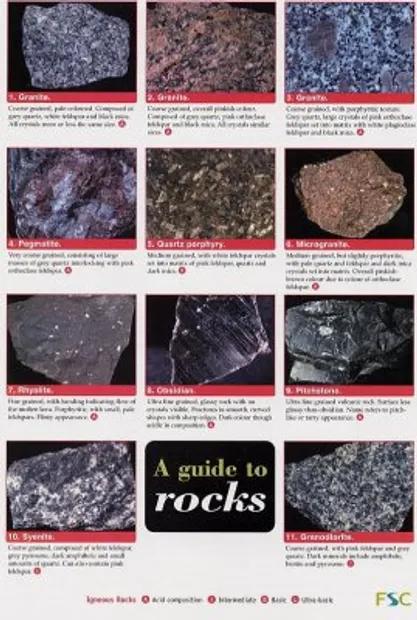Home / Shop
A Guide to Common Rocks


- Description
- Specifications
- Customer Reviews (0)
A Guide to Common Rocks
Author: Pellant & Pellant
The FSC Rocks guide features over 60 igneous, sedimentary and metamorphic rocks.
Rocks are everywhere. Crushed rock is, for example, an ingredient for making road surfaces. Stone and brick, made from clay, are both important in construction. Many houses have roofs of slate. In gardens rocks provide decoration and paving. Rock salt is on many tables. Sometimes polished slabs of beautifully crystalline granite decorate the front of shops and offices. And exposures of rock occur widely, especially in river valleys and at the seaside.
Photographs and text describe how to recognise each rock in the field.
Igneous rocks – formed by cooling of magma. In this case, texture, composition and acidity are important. Acid igneous rocks, such as granite and rhyolite, have over 65% total silica. Often they are pale in colour and have low density. By contrast basic igenous rocks, such as basalt and doleriate, have 45-55% total silica.
Sedimentary rocks – formed from grains worn off older rocks, by weathering and erosion. They split into detrital, organic and chemical sedimentary rocks. Therefore grain size and shape, colour and composition are useful clues.
Metamorphic rocks – formed by heat or pressure on older rocks. Rocks produced by contact metamorphism, such as marble and hornfels, are crystalline. On the other hand, rocks produced by regional metamorphism may be less strongly changed.
In essence a rock is an aggregate of mineral particles. These minerals are chemical compounds or single elements, often with crystalline shapes. Silicon, oxygen, aluminium, iron, calcium and sodium are some of the commonest rock-forming elements in the Earth’s crust. In turn the minerals making up rocks include silicates (like feldspars and micas), quartz and calcite.
